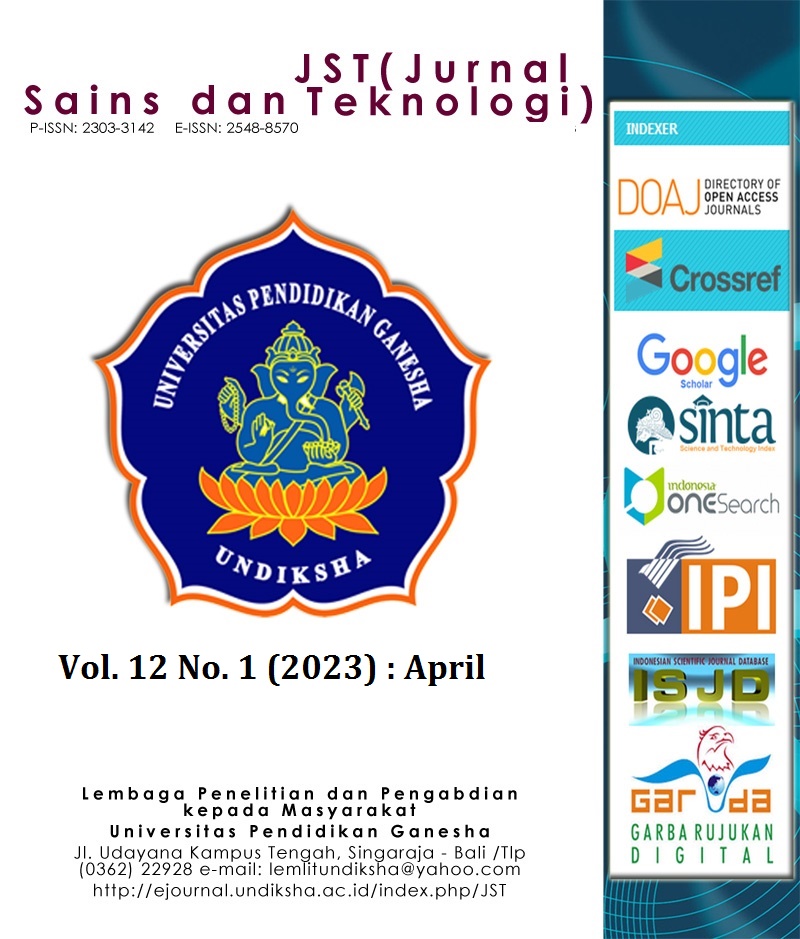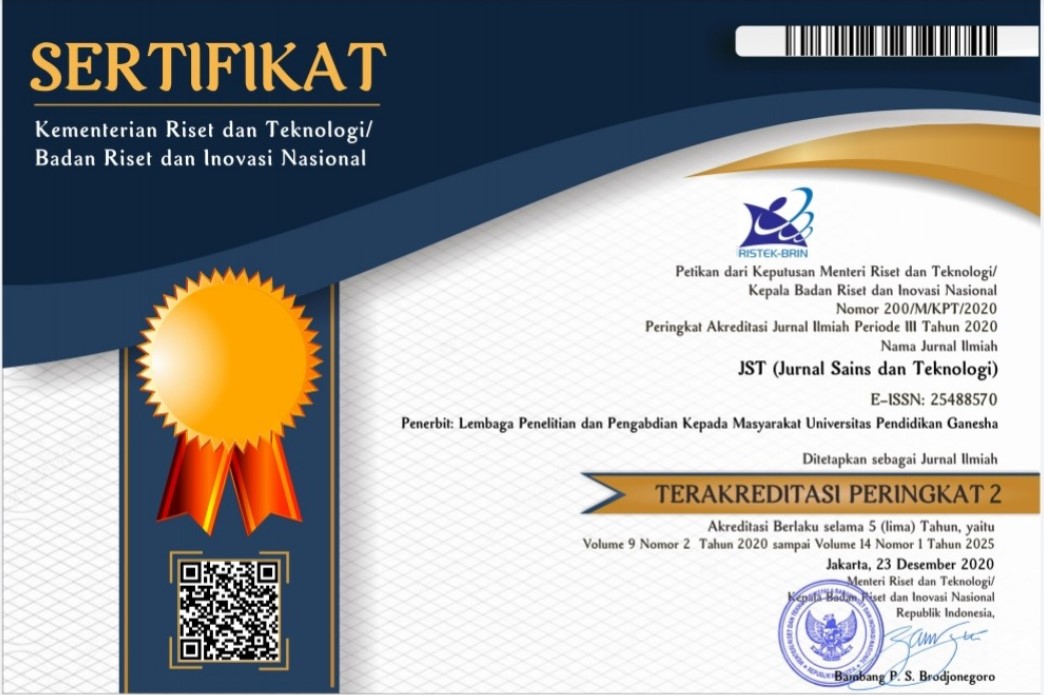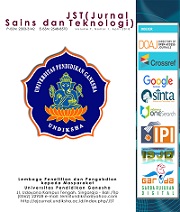Optimasi Proses Fermentasi Optimasi Proses Fermentasi Senyawa Antifungi oleh Bacillus subtilis CAF3 Terhadap Athelia rolfsii (Curzi) C. C. Tu &Kimbr.
DOI:
https://doi.org/10.23887/jstundiksha.v12i1.51317Kata Kunci:
Antifungi, Bacillus subtilis, Athelia rolfsii, efektivitasAbstrak
Bacillus subtilis CAF3 adalah bakteri endofit yang potensial dalam menghasilkan senyawa antifungi. Bakteri ini memiliki senyawa yang dapat menghambat pertumbuhan Athelia rolfsii. Produksi senyawa antifungi tersebut dapat ditingkatkan dengan melakukan optimasi pada proses fermentasinya. Pada penelitian ini dilakukan pemilihan media fermentasi, optimasi konsentrasi inokulum, optimasi pH awal media dan optimasi agitasi, selain itu juga dilakukan uji bioaktivitas ektrak hasil fermentasi serta identifikasi senyawa dengan menggunakan LC/MS. Hasil penelitian menunjukkan hasil fermentasi B. subtilis CAF3 memiliki daya hambat tertinggi terhadap A. rolfsii pada media tryptic soy broth (90,59%), konsentrasi inokulum 5% (90,59%), pH awal media 7 (90,59%) dan agitasi 110 rpm (90,59%). Ektrak etil asetat menghasilkan jumlah senyawa terbanyak (228 mg/L) dan memiliki bioaktivitas tertinggi (100%). Hasil LC/MS menunjukkan terdapat empat senyawa yang berbeda yaitu: T1.86 (392 m/z), T2.24 (261,59 m/z), T2.67 /mL (436,04 m/z) dan T3.28 (282,23 m/z). Senyawa-senyawa tersebut berbeda dengan senyawa yang umum dihasilkan oleh B. subtilis.
Referensi
Ahmad, A. M., Attia, A. G., Mohamed, M. S., & Elsayed, H. E. (2019). Fermentation , formulation and evaluation of PGPR Bacillus subtilis isolate as a bioagent for reducing occurrence of peanut soil-borne diseases. Journal of Integrative Agriculture, 18(9), 2080–2092. https://doi.org/10.1016/S2095-3119(19)62578-5.
Ahmadzadeh, M., & Behboudi, K. (2009). Interaction Of Different Media On Production And Biocontrol Efficacy Of Pseudomonas Fluorescens P-35 And Bacillus Subtilis B-3 Against Grey Mould Of Apple, 91, 65–70.
Awan, Z. A., & Shoaib, A. (2019). Current Plant Biology Combating early blight infection by employing Bacillus subtilis in combination with plant fertilizers. Current Plant Biology, 20(September), 100125. https://doi.org/10.1016/j.cpb.2019.100125.
Bacillus licheniformis. (2012), 01(04), 498–510.
Battu, P., & Reddy, M. (2009). Isolation of secondary metabolites from Pseudomonas fluorescens and its Characterization. Asian Journal of Research in Chemistry, 2(1), 26–29.
Bhoonobtong, A., Sawadsitang, S., & Sodngam, S. (2012). Characterization of Endophytic Bacteria , Bacillus Amyloliquefaciens for Antimicrobial Agents Production. International Proceedings of Chemical, Biological & Environmenta, 40, 6–11.
Chung, S., Kong, H., Buyer, J. S., Lakshman, D. K., Lydon, J., Kim, S., & Roberts, D. P. (2008). Isolation and partial characterization of Bacillus subtilis ME488 for suppression of soilborne pathogens of cucumber and pepper, 115–123. https://doi.org/10.1007/s00253-008-1520-4.
Dalal, J., & Kulkarni, N. (2013). Antagonistic and Plant Growth Promoting Potentials of Indigenous Endophytic Bacteria of Soybean ( Glycine max ( L ) Merril ), 1(2), 62–69.
de Melo, F. M. P., Fiore, M. F., de Moraes, L. A. B., Silva-Stenico, M. E., Scramin, S., Teixeira, M. de A., & de Melo, I. S. (2009). Antifungal compound produced by the cassava endophyte Bacillus pumilus MAIIIM4A. Scientia Agricola, 66(5), 583–592. https://doi.org/10.1590/s0103-90162009000500002.
Farizan, N. (2006). Production of Bioactive Compounds by Bacillus subtilis against Sclerotium rolfsii, 2(2), 19–23.
Hadiwiyono, H., & Widono, S. (2012). Endophytic Bacillus : the potentiality of antagonism to wilt pathogen and promoting growth to micro-plantlet of banana in vitro. Biomirror, 3(June), 1–4.
Handayani, D., Sandrawaty, N., Murniati, M., & Regina, R. (2015). Screening of endophytic bacteria isolated from marine sponge Haliclona fascigera for inhibition against clinical isolates of methicillin resistant Staphylococcus aureus (MRSA). Journal of Applied Pharmaceutical Science, 5(9), 139–142. https://doi.org/10.7324/JAPS.2015.50926.
Hanson, J. (2003). Tutorial Chemistry Texts -- Natural Products: The Secondary Metabolites, 154.
He, C. P., Fan, L. Y., Wu, W. H., Liang, Y. Q., Li, R., Tang, W., … Zheng, F. C. (2017). Identification of lipopeptides produced by Bacillus subtilis Czk1 isolated from the aerial roots of rubber trees. Genetics and Molecular Research, 16(1), 1–13. https://doi.org/10.4238/gmr16018710.
Huang, J., Wei, Z., Tan, S., Mei, X., Shen, Q., & Xu, Y. (2014). Suppression of Bacterial Wilt of Tomato by Bioorganic Fertilizer Made from the Antibacterial Compound Producing Strain Bacillus amyloliquefaciens HR62.
Islam, R., Jeong, Y. T., Lee, Y. S., & Song, C. H. (2012). Isolation and identification of Antifungal compounds from bacillus subtilis C9 Inhibiting the growth of plant pathogenic fungi. Mycobiology, 40(1), 59–66. https://doi.org/10.5941/MYCO.2012.40.1.059.
Joshi, S., Bharucha, C., & Desai, A. J. (2008). Production of biosurfactant and antifungal compound by fermented food isolate Bacillus subtilis 20B. Bioresource Technology, 99(11), 4603–4608. https://doi.org/10.1016/j.biortech.2007.07.030.
Kaaria, P., Matiru, V., & Ndungu, M. (2012). Antimicrobial activities of secondary metabolites produced by endophytic bacteria from selected indigenous Kenyan plants. African Journal of Microbiology Research, 6(45), 7253–7258. https://doi.org/10.5897/AJMR12.785
Kambar, Y., Manasa, M., Vivek, M., & TR, P. K. (2014). Inhibitory Effect of Some Plants of Western Ghats of Karnataka against. Science, Technology and Arts Research Journal, 3(2), 76–82.
Lacerda, A., De Carvalho, U., Henrique, F., Corrêa De Oliveira, P., De Lima, R., Mariano, R., … Souto-Maior, A. M. (2010). BRAZILIAN ARCHIVES OF BIOLOGY AND TECHNOLOGY Growth, Sporulation and Production of Bioactive Compounds by Bacillus subtilis R14. Arch. Biol. Technol. V, 53353(3), 643–652.
Li, J., Yang, Q., Zhao, L. H., Zhang, S. M., Wang, Y. X., & Zhao, X. Y. (2009). Purification and characterization of a novel antifungal protein from Bacillus subtilis strain B29. Journal of Zhejiang University: Science B, 10(4), 264–272. https://doi.org/10.1631/jzus.B0820341.
Mao, X. L. J. Y. Z. (2014). Enhancement of Biocontrol Activities and Cyclic Lipopeptides Production by Chemical Mutagenesis of Bacillus subtilis XF-1 , a Biocontrol Agent of Plasmodiophora brassicae and Fusarium solani. https://doi.org/10.1007/s12088-014-0471-y.
Niyaz, A. (2012). Isolation and identification of secondary metabolites producing organisms from marine sponge. Discovery, 1(1), 14–17.
Nor Irham Nor Azan, M., Kamal, P. N. S. M. M., Rasmadi, M. A. A., Adzhar, M. H., Zakaria, M. A., Taufek, A. S. A., … Alikasturi, A. S. (2020). Production of biodiesel from palm oil refinery pilot plant waste using Ni/CaO (ES) catalyst. Materials Today: Proceedings, 31, 292–299. https://doi.org/10.1016/j.matpr.2020.06.012.
Omowumi, A., & Samuel, T. (2014). Antifungal activities of Bacillus subtilis isolated from some condiments and soil, 8(18), 1841–1849. https://doi.org/10.5897/AJMR2013.6162.
Putri, R. E., Mubarik, N. R., Ambarsari, L., & Wahyudi, A. T. (2021). Antagonistic activity of glucanolytic bacteria Bacillus subtilis W3.15 against fusarium oxysporum and its enzyme characterization. Biodiversitas, 22(9), 4067–4077. https://doi.org/10.13057/biodiv/d220956.
Rautela, R., Kumar, A., & Abha, S. (2014). Lipopeptides from Bacillus strain AR2 inhibits biofilm formation by Candida albicans. https://doi.org/10.1007/s10482-014-0135-2.
Sidorova, T. M., Asaturova, A. M., Homyak, A. I., Zhevnova, N. A., Shternshis, M. V., & Tomashevich, N. S. (2020). Optimization of laboratory cultivation conditions for the synthesis of antifungal metabolites by bacillus subtilis strains. Saudi Journal of Biological Sciences, 27(7), 1879–1885. https://doi.org/10.1016/j.sjbs.2020.05.002.
Stanbury, P. F., Whitaker, A., & Hall, S. J. (2016). Principles of Fermentation Technology: Third Edition. Principles of Fermentation Technology: Third Edition, 1–803.
Thomashow, L. S., Bonsall, R. F., & Weller, D. M. (2008). Detection of Antibiotics Produced by Soil and Rhizosphere Microbes In Situ, 23–36.
Tian, Y., Fan, Y., Liu, J., Zhao, X., & Chen, W. (2016). Effect of nitrogen , carbon sources and agitation speed on acetoin production of Bacillus subtilis SF4-3. EJBT, 19, 41–49. https://doi.org/10.1016/j.ejbt.2015.11.005.
Uaac, A. A. F., Djamaan, A., Agustien, A., Zam, S. I., Jannah, M., Lalfari, R. S., … Suci, R. P. (2018). Research Article, 9(8), 21–26. https://doi.org/10.7897/2230-8407.098158.
Usall, J., Atare, E., Vin, I., Costa, E., & Teixido, N. (2002). The effect of nitrogen and carbon sources on growth of the biocontrol agent Pantoea agglomerans strain CPA-2, 117–120.
Wang, N. N., Yan, X., Gao, X. N., Niu, H. J., Kang, Z. S., & Huang, L. L. (2016). Purification and characterization of a potential antifungal protein from Bacillus subtilis E1R-J against Valsa mali. World Journal of Microbiology and Biotechnology, 32(4), 1–10. https://doi.org/10.1007/s11274-016-2024-5.
Wu, W. J., Park, S. M., & Ahn, B. Y. (2013). Isolation and characterization of an antimicrobial substance from Bacillus subtilis BY08 antagonistic to Bacillus cereus and Listeria monocytogenes. Food Science and Biotechnology, 22(2), 433–440. https://doi.org/10.1007/s10068-013-0098-5.
Yánez-mendizábal, V., Viñas, I., Usall, J., Torres, R., Solsona, C., & Teixidó, N. (2012). Production of the postharvest biocontrol agent Bacillus subtilis CPA-8 using low cost commercial products and by-products, 60, 280–289. https://doi.org/10.1016/j.biocontrol.2011.12.001.
Zam, S. I., Agustien, A., Djamaan, A., & Mustafa, I. (2019). The Diversity of Endophytic Bacteria from the Traditional Medicinal Plants Leaves that Have Anti-phytopathogens Activity, 9(1), 53–63. https://doi.org/10.11594/jtls.09.01.08.
Zhang, Y., Wang, X., Liang, S., Shi, Y., Chen, X., Liu, J., & Wang, A. (2021). Fermentation optimization, fungistatic effects and tomato growth promotion of four biocontrol bacterial strains. Agriculture (Switzerland), 11(7), 1–18. https://doi.org/10.3390/agriculture11070686.
Zhao, Q., Dong, C., Yang, X., Mei, X., Ran, W., Shen, Q., & Xu, Y. (2011). Biocontrol of Fusarium wilt disease for Cucumis melo melon using bio-organic fertilizer. Applied Soil Ecology, 47(1), 67–75. https://doi.org/10.1016/j.apsoil.2010.09.010.
Zhao, Q., Mei, X., Xu, Y., & Engineering, N. (2016). Isolation and Identification of Antifungal Compounds Produced by Bacillus Y-IVI for Suppressing Fusarium Wilt of Muskmelon, 52(3), 167–175. https://doi.org/10.17221/70/2015-PPS.
Unduhan
Diterbitkan
Cara Mengutip
Terbitan
Bagian
Lisensi
Hak Cipta (c) 2022 Syukria Ikhsan Zam

Artikel ini berlisensiCreative Commons Attribution-ShareAlike 4.0 International License.
Authors who publish with the Jurnal Sains dan Teknologi (JST) agree to the following terms:
- Authors retain copyright and grant the journal the right of first publication with the work simultaneously licensed under a Creative Commons Attribution License (CC BY-SA 4.0) that allows others to share the work with an acknowledgment of the work's authorship and initial publication in this journal.
- Authors are able to enter into separate, additional contractual arrangements for the non-exclusive distribution of the journal's published version of the work (e.g., post it to an institutional repository or publish it in a book), with an acknowledgment of its initial publication in this journal.
- Authors are permitted and encouraged to post their work online (e.g., in institutional repositories or on their website) prior to and during the submission process, as it can lead to productive exchanges, as well as earlier and greater citation of published work. (See The Effect of Open Access)
















